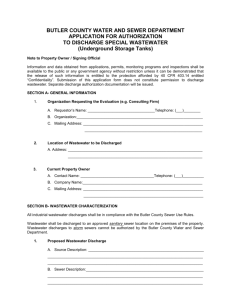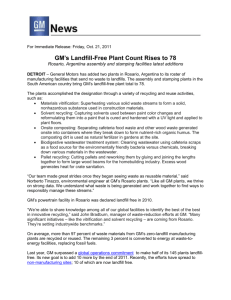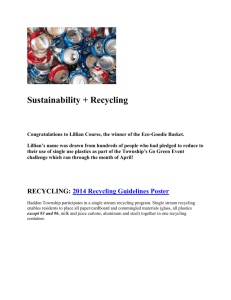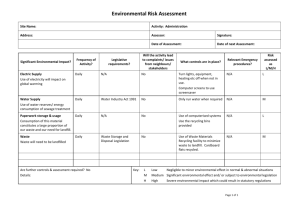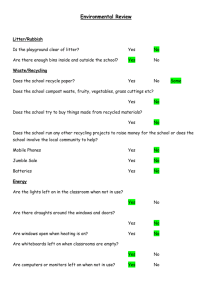Exploring global nitrogen and phosphorus flows in urban wastes
advertisement
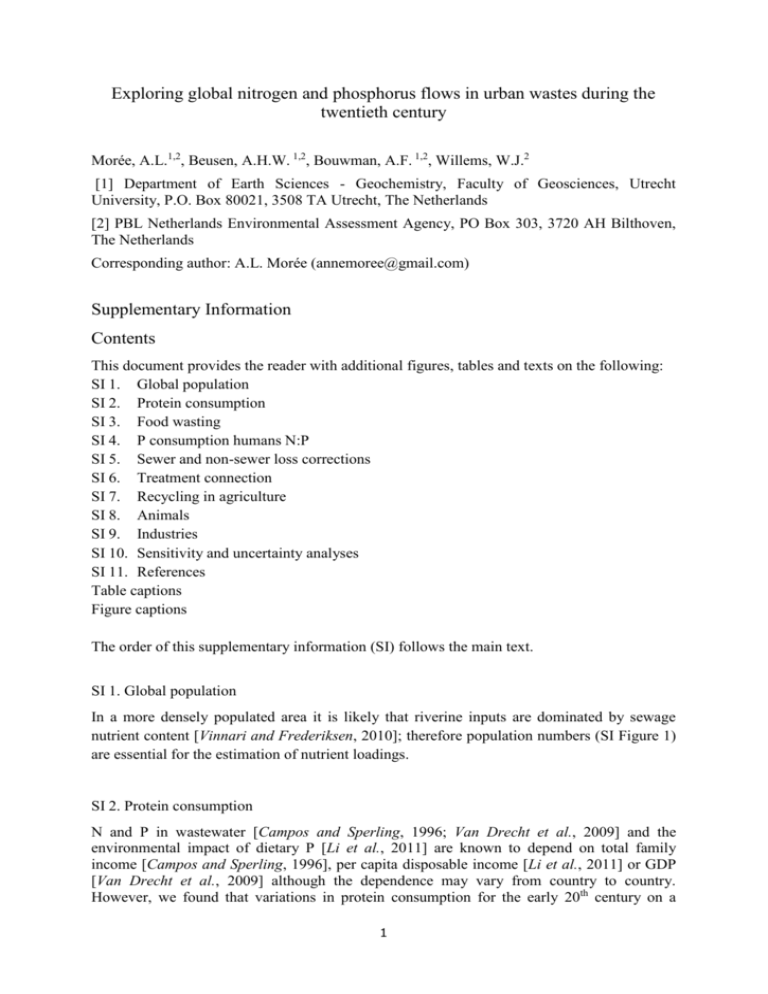
Exploring global nitrogen and phosphorus flows in urban wastes during the twentieth century Morée, A.L.1,2, Beusen, A.H.W. 1,2, Bouwman, A.F. 1,2, Willems, W.J.2 [1] Department of Earth Sciences - Geochemistry, Faculty of Geosciences, Utrecht University, P.O. Box 80021, 3508 TA Utrecht, The Netherlands [2] PBL Netherlands Environmental Assessment Agency, PO Box 303, 3720 AH Bilthoven, The Netherlands Corresponding author: A.L. Morée (annemoree@gmail.com) Supplementary Information Contents This document provides the reader with additional figures, tables and texts on the following: SI 1. Global population SI 2. Protein consumption SI 3. Food wasting SI 4. P consumption humans N:P SI 5. Sewer and non-sewer loss corrections SI 6. Treatment connection SI 7. Recycling in agriculture SI 8. Animals SI 9. Industries SI 10. Sensitivity and uncertainty analyses SI 11. References Table captions Figure captions The order of this supplementary information (SI) follows the main text. SI 1. Global population In a more densely populated area it is likely that riverine inputs are dominated by sewage nutrient content [Vinnari and Frederiksen, 2010]; therefore population numbers (SI Figure 1) are essential for the estimation of nutrient loadings. SI 2. Protein consumption N and P in wastewater [Campos and Sperling, 1996; Van Drecht et al., 2009] and the environmental impact of dietary P [Li et al., 2011] are known to depend on total family income [Campos and Sperling, 1996], per capita disposable income [Li et al., 2011] or GDP [Van Drecht et al., 2009] although the dependence may vary from country to country. However, we found that variations in protein consumption for the early 20th century on a 1 country basis could not be explained by GDP at the county scale, particularly not in developing regions. For countries with incomplete data, missing years were completed using population weighed regional (SI Figure 2) averages (SI Figure 3). Countries with missing protein consumption data for some years are: Afghanistan, American Samoa, Andorra, Anguilla, Aruba, Bahrain, Bhutan, Br.Virgin Is., British Indian Ocean Territory, Cayman Islands, China (Hong Kong SAR), China (Macao SAR), Christmas Isl., Cocos (Keeling) Isl., Cook Islands, Faeroe Islands, Falkland Is., Gibraltar, Greenland, Guadaloupe, Guam, Heard and McDonald Isl., Holy See, Iraq, Liechtenstein, Marshall Islands, Martinique, Micronesia (Fed. States of), Monaco, Montserrat, Nauru, Niue, Norfolk Isl., Northern Mariana, Oman, Palau, Papua New Guinea, Pitcairn, Puerto Rico, Qatar, Reunion, San Marino, Singapore, Somalia, St. Helena, St.Pierre & Miq., Svalbard & Jan Mayen Isl., Taiwan, Tokelau, Tonga, Turks & Caicos, Tuvalu, U.S. Virgin Is., Wallis & Futuna, Western Sahara. Although inter-regional differences remain close to 30 g protein cap-1 d-1, differences between countries can be large; the largest difference (lowest and highest value for protein consumption) in the dataset is 130 g protein cap-1 d-1 between Occupied Palestinian Territory (11 g protein cap-1 d-1) and Iceland (141 g protein cap-1 d-1) in 1986 (SI Figure 3) [FAO, 2012]. SI 3. Food wasting A recent study by the Swedish Institute for Food and Biotechnology and the FAO based on the Food Balance Sheets of the FAO [FAO, 2012] indicated that at present ~40% of total losses between food production and consumption occur at the retail and consumer level and strongly depend on the type of food consumed [SIK/FAO, 2011]. The SIK/FAO data form the basis of the average retail and household food loss corrections made in this study (SI Table 2). For different food groups, the actual waste loss is between 0.5 and 17% for retail wasting and between 0.1 and 33% for household wasting [SIK/FAO, 2011]. In this study we use averages for all food groups (SI Table 2). Higher food losses exist as well; for example household wasting of up to 50% of leafy salads. It is therefore stressed that uncertainties are large [Parfitt et al., 2010]. SI 4. P consumption humans N:P Dairy products, meat, and fish are particularly important sources of phosphorus. Since these are also the major nitrogen-containing foods, a close correlation exists between protein consumption (N consumption) and P consumption (for example for the U.S.A. as discussed in the main text, see SI Figure 5). In recent years, total P consumption increased by the various polyphosphate food additives (added to improve consistency and appearance of foods) and P in most soft drinks in the form of phosphoric acid [J. Higdon, 2003; Takeda et al., 2012]. P-to-protein ratios were reported to have increased 28% and even up to almost 100% for processed foods compared to additivefree products [Sherman and Mehta, 2009]; it is therefore likely that in the future N:P ratios in food will decrease. 2 SI 5. Sewer and non-sewer loss corrections 19th century sewer pipes, if present at all, were often made from bricks and mortar with a relatively open structure, thereby permitting leakage to the soil and groundwater. Only in the later 19th century less permeable concrete pipes were used in the cities in industrialized countries around the world. However, also far into the 20th century, the techniques and materials used are still being improved [Jones, 1998]. Therefore, sewer losses through leakage were considered in our model. Exfiltration studies on current sewer pipes show large variations in leakage measurements. For example, ~1% up to 38% of waste water is reported to leak into the groundwater according to Rutsch [2006] and Rutsch et al. [2005]. Low leakage fractions may be due to sealing of pipes with sewage and sewage sediments thereby preventing leakage [Blackwood et al., 2005]. At present, high concentrations of nutrients are often found in urban soil- and groundwater and these have been caused by leakage from sewer systems, septic tanks, pipes, landfills, urban fertilizer use, gas works and airplane de-icing leakages of nutrients [Wakida and Lerner, 2005]. A quantification of the sewer leaks is difficult due to the large variations in measurements and the lack of data on the global scale. We assumed a constant global sewer pipe leakage of 5% for both N and P. In addition, settling of nutrient-rich particles, biological degradation and volatilization during transportation through the sewer pipes are assumed to cause a loss of 5%. Hence, a total correction of 10% ‘sewer losses’ was made for both N and P flows for households with a sewer connection. It is assumed that 20% of all N excreta from persons lacking a sewer connection is lost through volatilization. Although non-sewered human excreta are often kept in more confined conditions (tons/pipes/buckets/cesspits/pit latrines), thereby limiting the volatilization of N, the N in excreta are still found to volatilize at a rate similar to animal waste volatilization losses of 20% from animal houses [Kimura et al., 2005]. The process can be of major relevance to ammonia emissions, as evidenced by present emissions from human excreta in Chinese urban areas that have an important contribution to urban air pollution there [Huang et al., 2012]. SI 6. Treatment connection Treatment of wastewater from households or industries (SI Figure 7) can occur locally (septic tanks, cesspits, etc.) or by a centralized system (sewer pipe network). The method selected by a city or region depends on costs, tradition, scientific theories, public opinion and urban development [Burian et al., 2000]. Since making changes in these systems is complex, time consuming and expensive, once a method was chosen it often remained in use for a long period. In most parts of the world, public centralized system wastewater collection in sewage systems and wastewater treatment seem to be the preferred methods since the late 19th century. 3 Early 20th century urban wastewater nutrient recycling in agriculture (SI 7) was often regarded as a way of treatment. For example, during the first decennia of the 20th century land treatment and sewage farming were practiced at a large scale in China [Li et al., 2011], thereby decreasing surface water nutrient discharges. In Germany, infiltration beds treated a major part of Berlins wastewater in the early 20th century [Shuval, 1986]. Since many of these examples combine treatment with crop production, our model considers all nutrient flows to agriculture as recycling, and not as a form of treatment. SI 7. Recycling in agriculture The classification was made based on IMAGE world regions (SI Figure 4) and inferred from mostly quantitative descriptions of wastewater recycling in agriculture as described in the main text. The year 1900 was used as a base year, forming a starting point from which the development in agricultural recycling was calculated for the rest of the 20th century. SI 8. Animals SI 8.1 Non-equidae urban livestock Although quantification is difficult, countries found to have low equidae stocks may have had higher numbers of other traction animals. Besides, non-equidae animals were kept as an additional food source of milk and meat. Since one horse or cow excretes about the same amount of N and P as 10 humans, their contribution to urban nutrient flows can be considerable. Dairy cattle kept for industrial production of milk and fed residues of beer breweries in urban areas was common in early 20th century Copenhagen, various cities in the U.S.A., Mexico City, and even up to today in Dar-es-Salaam [FAO, 2001]. It has been estimated that ~50% of the inhabitants of the city of Mwanza (Tanzania) and 37% in Dar-esSlaam had dairy cows at the end of the 20th century [FAO, 2001]. Also free roaming chickens, goats, sheep and pigs may attribute to urban livestock excretion, though many of these animal wastes are thought to end in the soil and atmosphere. Since total animal excreta in urban areas has a small influence on surface water N and P discharges (main text Figure 4), the effect of excreta from non-equidae livestock is found to be low, in particular since the second half of the 20th century as described in the main text results and discussion. SI 8.2 Equidae N:P consumption ratio The N:P ratio in feed for equidae differs from the ratio of 10 kg N :1 kg P used for people in this study. Generally, livestock requires relatively more P in the feed due to the low digestibility. Average animal feed (horses, cattle, goats, chickens, etc.) over the several subbasins of the Red River Basin (Vietnam and China) has a N:P ratio of about 8:1, corresponding to the N:P ratio in grass of 8:1 [Quynh et al., 2005]. An N:P ratio of ~7.5:1 was estimated from the Dutch CVB [CVB, 1996] as the approximate average feed consumption of horses (different types of grass, hay and straw). According to the composition of grass and hay as estimated by [Kemme et al., 2005], horse feed has a N:P ratio of approximately 7:1. Although different studies thus report different N:P ratios, the relatively higher feed 4 consumption of P compared to human consumption indicates that the human N:P ratio of 10:1 is not applicable here. A ratio of 7:1 was used in this study to estimate animal P excretion based on literature values for animal N excretion (Table SI 1). In the early 20th century, in some cases feed crops for the urban animals were irrigated with wastewater (Melbourne, Australia and Linköping, Sweden; USA, Europe, Mexico City and Berlin) [Schmid Neset, 2005; Shuval, 1986]. SI 9. Industries Technological improvements of most industry types reduced nutrient waste emissions over the past 100 years, but some techniques (such as in breweries) have remained very similar [Billen et al., 1999]. Furthermore, the increasing amount and level of treatment of wastewater reduced actual nutrient loading to surface water over the 20th century. Due to the close connection with water use (rinsing, flushing, transporting, cooling, etc.), it is likely that all industrial nutrient flows (except for a small part that was treated) were directly discharged to surface water in the early 20th century. In addition, industries were likely to be concentrated in urban areas [Plaats, 1902], since workers are needed and because it is convenient to locate the production close to the potential consumers (the urban dwellers). For the current situation, Luu et al. [2012] showed in a regional study on the Red River Delta (northern Vietnam), that industrial wastewater emission in urbanized areas constitutes on average ~11% of domestic wastewater emission of nitrogen and ~19% of phosphorus. Quynh et al. [2005] estimated for the Red River Basin (China and Vietnam) that at present industrial N and P inputs are both ~10% of domestic inputs. These estimates correspond to a study on the Nete River (Belgium) where gross industrial loading of N was estimated to be ~11% of household gross N flows [Bixio et al., 2005]. In Sub Saharan Africa, domestic emissions to surface water are the major urban source of nutrients at present, but quantitative estimates are not available [Nyenje et al., 2010]. A Dutch study in 1922 stated that ‘Industry is the largest source of water pollution, even larger than communities.’ [Gelder, 1922], thereby summarizing most other findings of historical studies. For Western Europe, Billen et al. [1999] showed that for the Seine and Zenne river basins high river nutrients loads could be explained by industry, and not by sources of domestic origin. Late 19th century Zenne (Belgium) nutrient loadings were also found to be dominated by industrial loadings over domestic ones [Garnier et al., 2012]. Billen et al. [1999] concluded that in 1896/1897, industrial N and P waste production exceeded domestic waste production by a factor of 1.1-4. An earlier report from the same author estimates that industry accounted for ~2.7 times domestic emissions in 1897 for the Zenne river Basin (Belgium) [Billen et al., 1995]. However, domestic emissions are likely to be overestimated since no corrections were made for recycling of human wastes in agriculture; in addition, the estimate for industrial emissions was low (using high nutrient losses through settling) [Billen et al., 1995]. This suggests an even larger difference between industry and domestic nutrient flows than the factor of 2.7. The 1999 study of Billen et al. showed that in 1986 for the Zenne basin industrial N waste was only 43% of domestic and P waste was 18% 5 of domestic, where in the Seine basin in 1991-1994 industrial N waste was 10% of domestic and industrial P waste was 21% of domestic waste. SI 10. Sensitivity and uncertainty analyses SI 10.1. Sensitivity analysis Calculation of the SRC values for all model input parameters for surface water N and P discharge and agricultural recycling of N and P was done using LHS as described in the main text. Default ranges chosen to determine the sensitivity of the different parameters are provided in SI Table 3. The statistically significant (t-value > 2 or < -2) SRC-values are provided in Tables 4 and 5. SRC is independent of units, scale and size of the parameters. A positive SRC value indicates that increasing that parameter value will cause an increase in the calculated output, while a negative value indicates a decrease in output caused by that parameter increase. The sum of squares of SRC values of all parameters equals the coefficient of determination (R2), which for a perfect fit equals 1. Hence, SRC2/R2 yields the contribution of a model parameter to model output. For example, a parameter with SRC = 0.1 adds 0.01 or 1% to model output in case R2 equals 1. 1. Sensitivity of N and P discharge to surface water. The sensitivity analysis shows that human population numbers, sewer connection, N as a fraction of protein and protein consumption are important parameters for surface water N and P discharge for all years (SI Table 4). Surface water discharge is also sensitive to the industrial nutrient flows in 1900 and tertiary treatment in 2000 for N and P and to the N:P ratio in food for P for all years. 2. Sensitivity of agricultural recycling. Regarding recycling of N and P (SI Table 5) in agriculture, important parameters are the presence of sewer connection, urban population and the fraction of human non-sewered wastes recycled in agriculture for all years. For the year 1900, the maximum number of animals per inhabitant and total population are also important for the model output of agricultural recycling of N and P. These observations can be explained by the fact that urban population determines the urbanization fraction together with total population. The latter is also used to calculate urban animal numbers (main text section 2.3). Urbanization fraction determines whether the maximum of 1 animal per 20 inhabitants is reached (as has shown to be important for agricultural recycling in 1900). Sewer connection determines whether human wastes can end in agriculture (see article figure 1a) and is therefore relevant for all years. The maximum number of animals per inhabitant becomes unimportant for the agricultural recycling model output due to the dominance of human excreta and small animal stocks as a result of F. SI 10.2. Uncertainty analysis Table 6 provides uncertainty ranges as applied to each of the most sensitive parameters to obtain the results in main text Figure 5 a,b and SI Figure SI 11 a,b. 6 For agricultural recycling (Figure SI 11 a,b), the observations made for surface water discharge in the main text apply. In contrast to surface water discharge however, Europe is only a minor contributor to agricultural recycling after 1900 and therefore also less important for global uncertainty. For recent years, East and South Asia are the major contributors and uncertainties for agricultural recycling of N and P. SI 10.3. Further uncertainties Further uncertainties are related to the representation of nutrient flows in the model. For example, CBS [2013] suggests that our industrial N and P nutrient flows and domestic P flows may be underestimated for The Netherlands for the last decades of the 20th century. This may be due to our assumption that industries are located in urban areas only. A number of nutrient sources were not included in the model such as i) other solid household refuse and sewage as reported for Paris [Barles and Lestel, 2007] and ii) urban livestock other than equidae [FAO, 2001]. Early 20th century agricultural recycling uncertainty (SI Figure 11 a,b) is caused by animal stocks which are the major contributors in that period (Figure 4). Even if incorporation of non-equidae species would cause a doubling of the nutrient flow from urban animals, it would be relevant only for agricultural recycling in the early 20th century (Figure 4). Furthermore, the modeled urban system (Figures 1 a,b,c) may not be correct for some regions. Examples are i) recycling of urban wastes in aquaculture, particularly in Asia [WHO, 1989], ii) recycling of treated wastewater in agriculture [Drechsel et al., 2010; Schmid Neset et al., 2010], for example in Saudi Arabia, Peru, Israel and Jordan [Olson, 1987], iii) recycling in agriculture of untreated sewered wastewater such as in early 20th century Paris [Billen et al., 1995] and present-day India [Hofstedt, 2005]. In addition, on-site sanitation systems (e.g. septic tanks) may be important in some countries such as Japan [Gaulke, 2006] and the omission of the incineration of urban wastes (as reported for Paris [Barles, 2007]) may have caused overestimation of urban waste flows. The effect of including points ii) and iii) could be significant. In 2000, ~27% of N and ~32% of P in sewers is removed through treatment globally. If 10% of these removed nutrients were brought to agriculture instead of ‘other’, ~40% more N and ~50% more P would go to agriculture in 2000. In 1900, if 10% of global sewer N and P were led to agriculture instead of surface water (as reported for Paris), ~50% more N and ~30% more P would be led to agriculture globally. SI 11. References Barles, S. (2007), Feeding the city: Food consumption and flow of nitrogen, Paris, 1801–1914, Science of the Total Environment, 375, 48-58. Barles, S., and L. Lestel (2007), The nitrogen question: Urbanization, industrialization, and river quality in Paris, 1830-1939, Journal of Urban History, 33(5), 794-812. Billen, G., J. Garnier, C. Billen, and E. Hannon (1995), Global Change in Nutrient Transfer from Land to Sea: Biogeochemical processes in riversystems - Final ReportRep., Belgium. Billen, G., J. Garnier, C. Deligne, and C. Billen (1999), Estimates of early-industrial inputs of nutrients to river systems: Implication for coastal eutrophication, Science of the Total Environment, 243-244, 43-52. Bixio, D., C. Thoeye, J. D. Koning, D. Joksimovic, D. Savic, T. Wintgens, and T. Melin (2005), Wastewater reuse in Europe, Elsevier, Desalination 187, 89-101. 7 Blackwood, D. J., D. J. Gilmour, J. B. Ellis, D. M. Revitt, and A. Staines (2005), Exfiltration from sewers - Is it a Serious Problem?, in 10th International Conference on Urban Drainage, edited, Copenhagen, Denmark. Burian, S. J., S. J. Nix, R. E. Pitt, and S. R. Durrans (2000), Urban Wastewater Management in the United States: Past, Present, and Future, Journal of Urban Technology, 7(3), 33-62. Campos, H. M., and M. v. Sperling (1996), Estimation of Domestic Wastewater Characteristics in a Developing Country Based on Socio-Economic Variables, Water Science and Technology, 34(3-4), 71-77. CBS (2013), Stikstof en fosfor in Nederland, in StatLine, edited. CVB (1996), Verkorte Tabel Voedernormen Landbouwhuisdieren en Voederwaarde Veevoeders. Drechsel, P., C. A. Scott, L. Raschid-Sally, M. Redwood, and A. Bahri (2010), Wastewater Irrigation and Health Assessing and Mitigating Risk in Low-Income Countries, 433 pp., IWMI, London. FAO (2001), Livestock keeping in urban areas - A review of Traditional Technologies Based on Literature and Field Experiences, Agriculture and Consumer Protection. FAO (2012), Food Supply, in FAOSTAT Food Supply, edited. Garnier, J., N. Brion, J. Callens, P. Passy, C. Deligne, G. Billen, P. Servais, and C. Billen (2012), Modeling historical changes in nutrient delivery and water quality of the Zenne River (1790s-2010): The role of land use, waterscape and urban wastewater management, Journal of Marine Systems. Gaulke, L. S. (2006), On-site wastewater treatment and reuses in Japan, Proceedings of the Institution of Civil Engineers: Water Management, 159(2), 103-109. Gelder, B. J. (1922), Een Dreigend Gevaar, Water Bodem Lucht, 12, 129-132. Hofstedt, C. (2005), Wastewater use in Agriculture in Andhra Pradesh, IndiaRep., Department of Soil Sciences, Swedish University of Agricultural Sciences. Huang, X., Y. Song, M. Li, J. Li, Q. Huo, X. Cai, T. Zhu, M. Hu, and H. Zhang (2012), A high-resolution ammonia emission inventory in China, Global Biogeochemical Cycles, 26(1). J. Higdon, P. D. (2003), Phosphorus, edited, Oregon State University, Linus Pauling Institute. Jones, M. (1998), Sewer Leakage - Detection and Cures Rep. Kemme, P., G. Smolders, and J. D. Van der Klis (2005), Schatting van de uitscheiding van stikstof en fosfor door paarden, pony’s en ezelsRep. Rapport 05/I01614, Wageningen University. Kimura, S. D., L. Liang, and R. Hatano (2005), Influence of long-term changes in nitrogen flows on the environment: A case study of a city in Hokkaido, Japan, Nutrient Cycling in Agroecosystems, 70(3), 271-282. Li, G. L., X. Bai, S. Yu, H. Zhang, and Y. G. Zhu (2011), Urban Phosphorus Metabolism through Food Consumption: The Case of China, Journal of Industrial Ecology. Luu, T. N. M., J. Garnier, G. Billen, T. P. Q. Le, J. Nemery, D. Orange, and L. A. Le (2012), N, P, Si budgets for the Red River Delta (northern Vietnam): How the delta affects river nutrient delivery to the sea, Biogeochemistry, 107(1-3), 241-259. Nyenje, P. M., J. W. Foppen, S. Uhlenbrook, R. Kulabako, and A. Muwanga (2010), Eutrophication and nutrient release in urban areas of sub-Saharan Africa — A review, Science of the Total Environment, 408(3), 447-455. Olson, R. A. (1987), The Use of Fertilizers and Soil Amendments, John Wiley & Sons Ltd, New York. Parfitt, J., M. Barthel, and S. MacNaughton (2010), Food waste within food supply chains: Quantification and potential for change to 2050, Philosophical Transactions of the Royal Society B: Biological Sciences, 365(1554), 3065-3081. Plaats, J. D. v. d. (1902), Over het Verslag van de Staatscommissie tot Voorbereiding van Maatregelen Tegen Verontreiniging van Openbare Wateren – Meer Bijzonder in Verband met de Ervaringen en Toestanden te Utrecht, Tijdschrift voor Sociale Hygiene(5), 101-116. Quynh, L. T. P., G. Billen, J. Garnier, S. Théry, C. Fézard, and C. V. Minh (2005), Nutrient (N, P) budgets for the Red River basin (Vietnam and China), Global Biogeochemical Cycles, 19(2), 1-16. Rutsch, M. (2006), Assessment of Sewer Leakage by Means of Exfiltration Measurements and Modelling TestsRep., Technical University of Dresden, Dresden. Rutsch, M., J. Rieckermann, and P. Krebs (2005), Quantification of Sewer Leakage - A Review, in 10th International Conference on Urban Drainage, edited, Copenhagen, Denmark. Schmid Neset, T. S. (2005), Environmental Imprint of Human Food Consumption Linköping, Sweden 1870-2000, 101 pp, Linköping University, Linköping. Schmid Neset, T. S., J. Drangert, H. P. Bader, and R. Scheidegger (2010), Recycling of Phosphorus in Urban Sweden: A historical overview to prepare a strategy for the future, Water Policy, 12, 611-624. 8 Sherman, R. A., and O. Mehta (2009), Phosphorus and potassium content of enhanced meat and poultry products: Implications for patients who receive dialysis, Clinical Journal of the American Society of Nephrology, 4(8), 1370-1373. Shuval, H. I. (1986), Wastewater Irrigation in Developing Countries: Health Effects and Technical Solutions, Washington, D.C. : The World Bank. SIK/FAO (2011), Food Losses and Food Waste - Extent, Causes and PreventionRep., Rome, Italy. Takeda, E., H. Yamamoto, H. Yamanaka-Okumura, and Y. Taketani (2012), Dietary phosphorus in bone health and quality of life, Nutrition Reviews, 70(6), 311-321. Tobler, W., U. Deichmann, J. Gottsegen, and K. Maloy (1995), The global demography projectRep., National Center for Geographic Information and Analysis (NCGIA), Santa Barbara, California. Van Drecht, G., A. F. Bouwman, J. Harrison, and J. M. Knoop (2009), Global nitrogen and phosphate in urban wastewater for the period 1970 to 2050, Global Biogeochemical Cycles, 23(3). Vinnari, E. M., and H. Frederiksen (2010), Water, food and the economy, Environment and History, 16(2), 195212. Wakida, F. T., and D. N. Lerner (2005), Non-agricultural sources of groundwater nitrate: a review and case study, Water Research, 39(1), 3-16. 9 Table captions SI Table 1. List of time-independent model input parameters. Values are fractions unless stated otherwise. SI Table 2. Food losses and wasting at the retail and household level [SIK/FAO, 2011]. Values for years in between are obtained by linear interpolation. Globally, losses in 1900 are set equal to the lowest global loss percentage in 2010. SI Table 3. Sensitivity ranges applied to determine those model input parameters that the model output of surface water discharge, agricultural recycling or ‘other’ flows was most sensitive to. When multiplication was used to determine sensitivity, 0.8 and 1.2 were used as minimum and maximum value respectively. Otherwise, addition was used except for the maximum number of animals per inhabitant were the actual model input minimum and maximum values were defined. For 1900, all treatment variation was excluded from the model; for 1950 only secondary treatment and tertiary treatment were excluded, for 2000 all parameters were varied according to this table. SI Table 4. SRC values for all model input parameters for surface water discharge of N and P for the years 1900, 1950 and 2000. Empty cells indicate non-significant values. Positive bold values are SRC-values with a positive effect on the output of more than more than 4% (SRC>0.2), while negative bold values are SRC-values with a negative effect on the output of more than -4% (SRC<-0.2). SI Table 5. SRC values for all model input parameters for agricultural recycling of N and P for the years 1900, 1950 and 2000. Empty cells indicate non-significant values. Positive bold values are SRC-values with a positive effect on the output of more than more than 4% (SRC>0.2), while negative bold values are SRC-values with a negative effect on the output of more than -4% (SRC<-0.2). SI Table 6. Uncertainty ranges of the most sensitive parameters as determined from SI Table 4 and 5. To apply the uncertainty ranges to the model, multiplication was used for protein consumption, total population, industry fraction, N fraction of protein, urban population and N:P. For sewer connection, agriculture fraction and the industry loss fractions addition was used; the maximum number of animals per inhabitant was set to a minimal an maximum value instead of addition or multiplication. Tertiary treatment was absent in 1900 and 1950 and therefore excluded. 10 Figure captions SI Figure 1. Global urban, rural and total population during the 20th century in billions of people based on Klein Goldewijk et al. (2010). SI Figure 2. Classification of the world in 10 world regions (and Greenland and Antarctica) as used for the model outputs at continental scale. Greenland and Antarctica were excluded from the results and discussion in the main text. SI Figure 3. 20th century protein consumption in g cap-1 d-1 for 11 world regions (SI Figure 2). Data from 1960 onwards are based on FAO Food Balance Sheet statistics for most countries [FAO, 2012]. SI Figure 4. Regions used in the model for the calculation of population-weighed regionaverages if data were absent. The classification is based on the regions used in the IMAGE model [Bouwman et al., 2006]. SI Figure 5. Derivation of the 10:1 N:P ratio used in the model. A 20th century protein consumption dataset for the USA multiplied with 0.16 to obtain N consumption and 0.1 to obtain P consumption shows a good fit to actual P consumption [USDA, 2012]. SI Figure 6. 20th century sewer connection as a fraction of the total population having a sewer for 11 world regions (SI Figure 2). Data from 1970 onwards are taken from Van Drecht et al. (2009). SI Figure 7. 20th century treatment coverage expressed as a fraction of people with a sewer connection having primary, secondary or tertiary treatment for 11 world regions (SI Figure 2). Data from 1970 onwards are taken from Van Drecht et al. (2009). a) Primary treatment (with 10% N (10%-25%) removal and 11% (10%-29%) P removal), b) Secondary treatment (with 35% N removal (35%-45%) and 45% (45%-50%) P removal) and c) Tertiary treatment (with 80% N removal (60%-80%) and 90% (90%94%) P removal). Variations in nutrient removal percentages are caused by efficiencies of the respective countries to perform the level of treatment. SI Figure 8. World classification for 1900 in 4 levels of agricultural nutrient recycling. Low recycling (10%), medium recycling (40%) and high recycling (70%) are the classes of recycling of non-sewered human N and P in agriculture in 1900. SI Figure 9. Sum of the stocks of urban horses, donkeys and mules in millions of animals for 11 world regions (SI Figure 2) based on formula 1 in article section 2.3.1. The shape of the lines is determined by the interaction of urbanization [Klein Goldewijk et al., 2010], the total equidae dataset [FAO, 2008; Mitchell, 1993a, b; 1998] and factor F (article section 2.3.1, equation 1). SI Figure 10. Population-density based world distribution [Tobler et al., 1995] of surface water loading of N for the years a) 1900, b) 1950 and c) 2000. SI Figure 11. Total mass flows from urban areas to agriculture for 10 world regions and globally in Tg N yr-1 (a) and Tg P yr-1 (b). Uncertainties ranges (5% and 9% percentiles) are included based on the methods described in section 2.5 and SI 10. 11
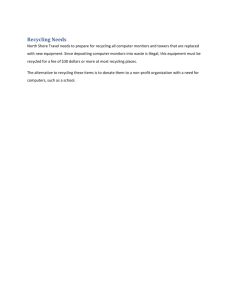
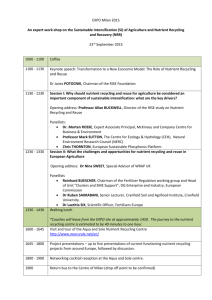
![School [recycling, compost, or waste reduction] case study](http://s3.studylib.net/store/data/005898792_1-08f8f34cac7a57869e865e0c3646f10a-300x300.png)
